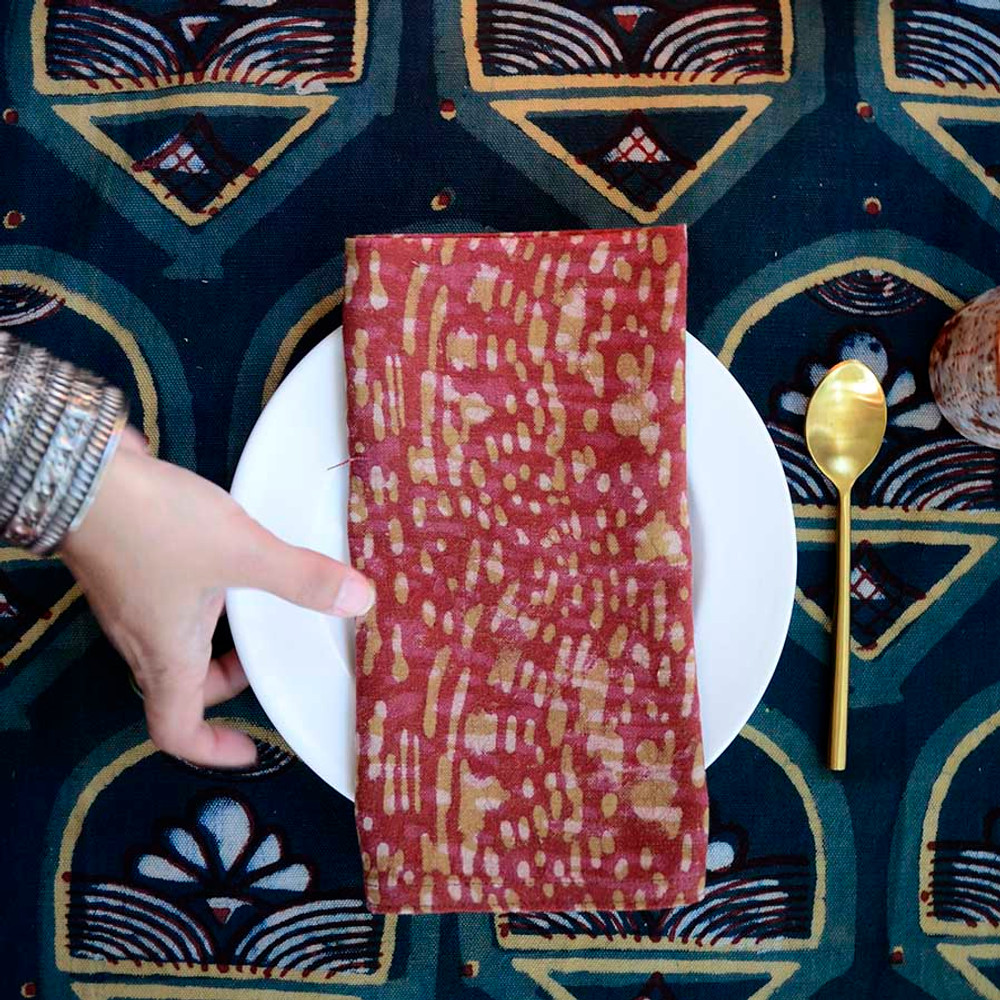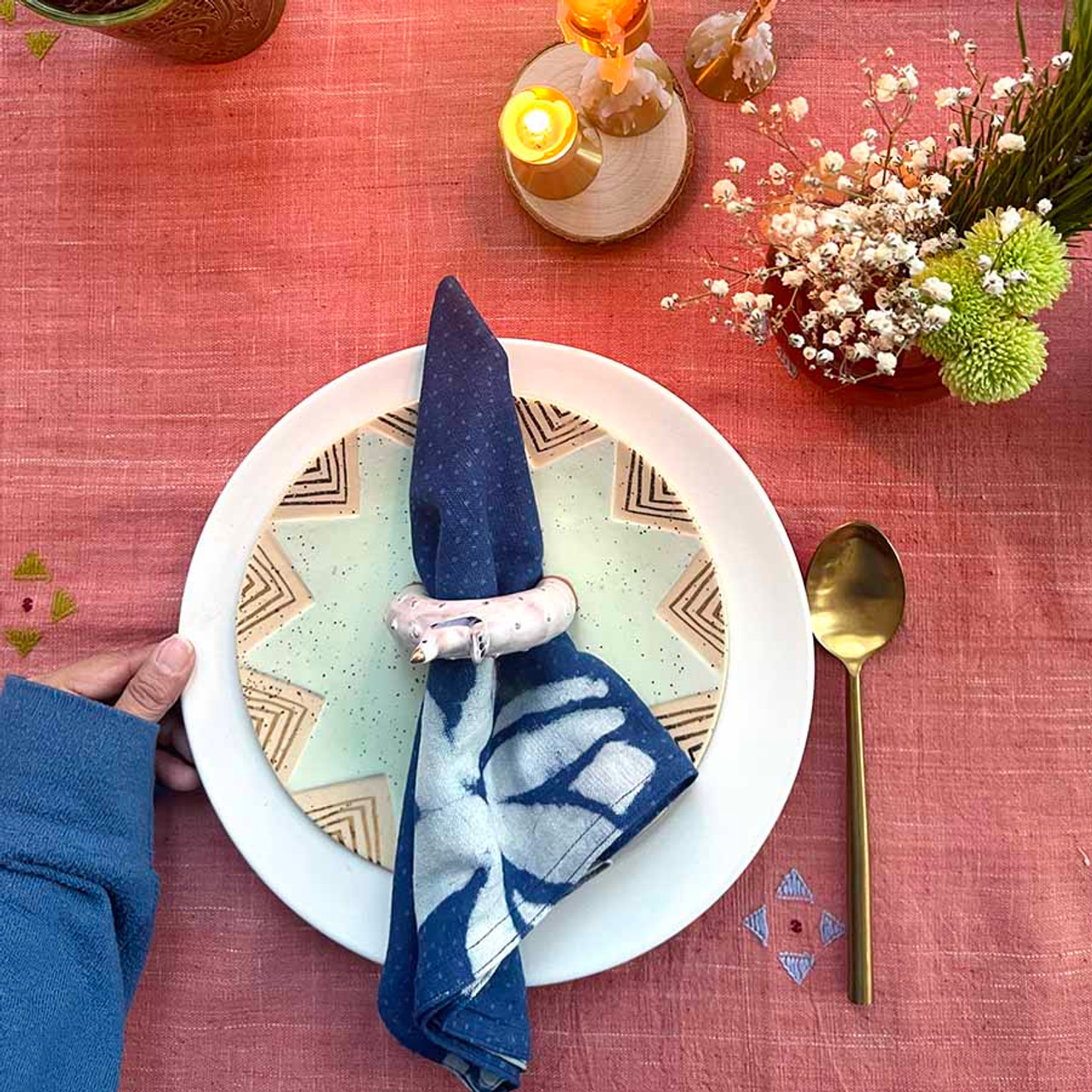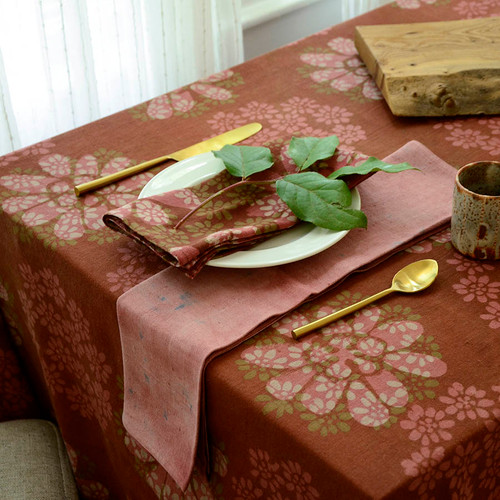Cloth Napkins 101: Best Fabrics, Sizes, and All You Need to Know
Posted by The Ichcha Team on 30th Aug 2025
From choosing the right napkin material and size to styling your tablescape, we cover it all in this blog.
Table of Contents
What's a cloth napkin?
A cloth napkin is a soft piece of fabric used to wipe your hands and mouth during meals. They're usually made of linen, cotton, and polyester. Unlike paper, cloth napkins are reusable. Cloth napkins range in size based on function. While a dinner napkin can measure around 19" square, a cocktail napkin for holding glasses typically ranges between 5" and 10" square.

Are cloth napkins worth it?
While paper napkins might seem affordable at first glance, cloth napkins are more cost-effective in the long term, as you can reuse the same napkin for 2-3 years with proper maintenance. So, cloth napkins are worth every penny.
Moreover, if you're looking to create a green, elegant table decor, cloth napkins are a great add. Cloth napkins are not only more sustainable than paper but also reflect your appreciation for aesthetics. They can instantly elevate the ambiance of your dining space.
For occasions like formal events and weddings, cloth dinner napkins are the more elegant choice. Cloth napkins are also best for everyday dining, as you don't have to spend on replacements every month.
What is the best fabric for cloth napkins?
Napkins come in different fabrics, including linen, cotton, polyester, and satin. The best type of cloth napkin is one made of 100% organic cotton. Cotton napkins are more cost-effective and absorbent than linen napkins. They wipe food stains better and feel pleasant against the skin.
If you're eco-conscious, note that polyester is bad for the environment, so you may want to steer clear. Plus, polyester isn't as absorbent as cotton and linen.
If you're concerned about the environmental impact of cheap conventional cotton, opt for napkins made of 100% organic cotton. Organic cotton has the least environmental impact of all fabrics.

Where should you place cloth napkins?
Fold and place napkins to the left of the forks for easy access. This makes it convenient for guests to access them during meals, as opposed to when they're under a cutlery or dinner plate. For aesthetics, you may also tuck a name card into a folded napkin and place it on the dinner plate. The guest can then place the napkin on their lap or to the left, whichever way they find convenient.
Such attention to detail showcases your commitment to hospitality.
It's also smart to keep a pile of clean napkins nearby so you can easily replace used ones during the meal. There might be a big spill sometimes, you know.
Read how to set wedding napkins.
What is a good size for cloth napkins?
Fabric napkins come in different sizes and types: The ideal size for dinner cloth napkins is typically around 19x19 inches square. Luncheon napkins range between 14-16 inches square, while cocktail napkins (aka beverage napkins) measure 5-10 inches square.
If you've got kids, opt for a napkin size that's easy for them to handle. Of course, you can buy a smaller napkin -- say, a cocktail one -- for your kids and get a larger one of 19x19 inches for yourself.
How do you select fabric colors and patterns?
Whether you prefer patterns or solid colors, always choose cloth napkins that harmonize with your table setting. If your dinnerware or tablecloth has patterns, consider using solid-colored napkins that complement the design. And if your tablecloth is a solid color, a patterned cloth napkin would be a great choice. This is advised, but it isn't a strict rule. You might want to experiment to see what works for your taste.
Check out this post on how to set wedding napkins.

Should napkins be the same color as the tablecloth?
For formal dining, it's safer and recommended to match the tablecloth with napkins of the same neutral colors. For casual and everyday dining, feel free to use printed napkins on neutral or similarly printed tablecloths to add a touch of fun to your table setting.
Matching napkins to the tablecloth can create a cohesive look, but this rule isn't set in stone. It's great to experiment with contrasts or complementary colors to add visual interest and depth to your table decor.
Read this blog to learn more about matching napkins and tablecloths.

Do you wash cloth napkins after every use?
It's a good practice to wash napkins after each use. Regular washing prevents stains from setting in and maintains their freshness and quality.
But this isn't always practical in real life, as people are busy. Lightly used napkins can be folded and reused by the same person. This is safe, but if you're worried about hygiene, you can keep a stack of napkins so that when one is being washed, there's always another fresh one available.
Also, ensure you follow the care instructions on the napkin's label as different fabric types are handled differently.
Learn more about how to wash naturally dyed cotton napkins.
How to wash cotton cloth napkins?
The right way to wash cotton napkins involves washing in cold water with mild detergent and air-drying flat away from direct sunlight. UV rays can cause fading. Avoid fabric softeners as they can ruin the fabric's absorbency.
For oil and wine spills, pre-treat the area immediately with a small amount of stain remover or baking soda and soak in water for 10-15 minutes. Then wash the napkin as usual.
Cotton napkins are best suited for casual and everyday dining.
Should fabric napkins be ironed?
Ironing napkins is optional, but it can enhance the overall aesthetic. Crisp, well-pressed napkins contribute to a polished table appearance, creating a more luxe dining experience for your guests.
That said, you can also prevent cotton napkins from wrinkling with proper washing and drying techniques, such as removing napkins from the dryer while they’re still slightly damp, then laying them flat or hanging them to air dry. For fabrics like cotton or linen, you might also try gently smoothing them out by hand before they dry completely. Storing napkins neatly folded or rolled instead of crumpled will also help them stay wrinkle-free. This way, you get the fresh, put-together look without the extra step every single time.
How do you layer napkins with runners and chargers?
To layer table linens and chargers, begin with a tablecloth and/or runner as the base, leaving a 6–12-inch drop for balance. Position charger plates about 2 inches from the table's edge, and place the dinner plate on the charger. Then fold cloth napkins on the plate or to the left of the forks to frame each place setting.
For a more elevated look, you can experiment with napkin rings, decorative folds, or even slipping a sprig of greenery or dried flowers inside the napkin for a natural touch. The key is to maintain symmetry while mixing textures—such as pairing a linen runner with cotton napkins or patterned chargers with solid napkins—to create a layered, cohesive table design that feels intentional yet inviting.

For a cohesive look, mix neutral tablecloths with printed napkins or combine solids with patterns. When using chargers, you don't necessarily need place mats.
How often do you need to replace fabric napkins?
With proper care, high-quality cotton napkins can last for years, often becoming softer and more comfortable with each wash. You only need to replace them when they show signs of excessive wear, thinning fabric, or stubborn stains that won’t come out. For households that use fabric napkins daily, consider rotating several sets to reduce strain on any one batch and extend their lifespan.
Special-occasion napkins, used less frequently, can last even longer if stored properly in a clean, dry space. You may also choose to refresh your collection every few years to update your table style, match new linens, or keep extras on hand for larger gatherings. Ultimately, replacement depends as much on personal preference and aesthetics as it does on durability.
What can you do with old cloth napkins?
Even if your table linens have served their dining purpose, they can find new life in creative ways. Repurpose old napkins and scarves as reusable cleaning cloths, sewing projects, or even decorative crafting elements. In more ways than one, cloth napkins are highly sustainable and shouldn't be left out of any eco-friendly dining.
What is the etiquette for cloth napkins?
Place the napkin on your lap as soon as you’re seated, use it to dab your mouth when needed, and fold it neatly beside your plate when finished. Avoid using it to wipe your face or place it on your plate after eating.
If you need to leave the table during the meal, place the napkin loosely on your chair until you return. When the meal is finished, fold it neatly and place it to the left of your plate or in the center of the place setting, but never on top of the plate itself. Avoid using it to clean spills, wipe your face, or blow your nose, as a cloth napkin is considered part of the table setting rather than a utility item.
These small gestures not only maintain a polished atmosphere but also show respect to your host and fellow guests.
Where to buy eco-friendly cloth napkins?
Green dining begins with using eco-friendly cloth napkins made of 100% organic fabric. Visit ichcha.com to shop for sustainable organic cotton napkins you and your dinner guests will love for years to come.
Shop our collection of eco-friendly block print napkins
Updated August 2025


